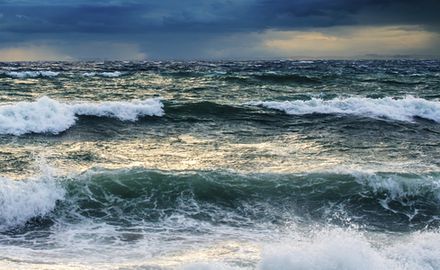

Waves rolling towards the shore. Photo: thinkstock
Together, the two studies give critical information for coastal planning. For expert assessments of future sea-level rise, the authors make the tool available online.
“With all the greenhouse-gases we already emitted, we cannot stop the seas from rising altogether, but we can substantially limit the rate of the rise by ending the use of fossil fuels,” says Anders Levermann, Research Domain Co-Chair for Adaptation at the Potsdam-Institute for Climate Impact Research (PIK), scientist at Columbia University’s Lamont-Doherty Earth Observatory, and co-author of the study on future sea-level rise. “We try to give coastal planners what they need for adaptation planning, be it building dikes, designing insurance schemes for floodings, or mapping long-term settlement retreat.”
+++Even if the Paris Agreement is implemented, adaptation is a challenge+++
The scientists will make the computer simulation code available online so experts can use the information and the estimation tool for risk assessments. Even if ambitious climate policy follows the 2015 Paris Agreement, sea levels are projected to increase by 20 to 60 centimeters by 2100 – hence the relevance for coastal protection. “This is quite a challenge, but less expensive than adaptation to unabated sea-level rise which in some regions is impossible”, Levermann adds. “If the world wants to avoid the greatest losses and damages, it now has to rapidly follow the path laid out by the UN climate summit in Paris a few weeks ago.”
For future sea-level rise, the scientists combine two approaches. To forecast sea-level rise, some scientists use process-based computer simulations that calculate the contribution of melting glaciers, ice sheet mass loss and the thermal expansion of sea-water from physical laws – warmer water takes more space. These simulations are computationally costly and slow. As an alternative, statistical analyses have been used to assess future sea-level rise quickly at low computational cost. “We designed our tool in a way it is consistent both with the past observations of sea-level rise and the long-term physical processes in the different elements of the Earth system,” says lead-author Matthias Mengel from PIK. “Importantly, our calculation method is fast, which makes it easy to reproduce and allows for a lot of simulation runs to provide probabilities of sea-level rise.”
The likely future sea-level rise cannot be brought down to just one number, but is represented as a range, which at first sight might seem large. “The range allows for a risk assessment,” says Ben Marzeion from the University of Bremen, Germany. “Coastal Planners need to know how a reasonable worst-case scenario as well as a well-founded best-case scenario look like to weigh chances and costs. The best available science is now converging towards a common uncertainty range of future sea-level rise. Curbing greenhouse gas emissions now gives us the chance to prevent sea level rise to accelerate further.”
+++During past millennia sea-level has never risen as fast as during the last century+++
The study on future sea-level rise turns out to be confirmed by the other one on past sea-level rise: they yield nearly identical sea-level rise estimates for the 21st century. Also, the new estimates overlap with those of the latest IPCC report.
“Our study is for sea level what the now well-confirmed famous ‘hockey stick’ diagram was for global temperature,” says Stefan Rahmstorf, co-author of the paper on past sea-level rise and Co-Chair of PIK’s research domain Earth System Analysis. “We can confirm what earlier, more local sea-level data already suggested: during the past millennia sea-level has never risen nearly as fast as during the last century.” Based on the analysis of the past millennia of natural sea-level variations, the new study was also able to estimate how much human activities have contributed to modern sea-level rise: Almost certainly more than half of the 20th Century rise has been caused by human activity, possibly even all of it.
Confirming previous assumptions, as boring as it might sound, is of key relevance for the progress of science. “We can now show the effect in an unprecedentedly robust way, based upon the statistical analysis of a global database of regional sea-level reconstructions,” says Rahmstorf. “The new sea-level data confirm once again just how unusual the age of modern global warming due to our greenhouse gas emissions is – and they demonstrate that one of the most dangerous impacts of global warming, rising seas, is well underway.”
Article on future sea-level rise: Mengel, M., Levermann, A., Frieler, K., Robinson, A., Marzeion, B., Winkelmann, R. (2016): Future sea-level rise constrained by observations and long-term commitment. Proceedings of the National Academy of Sciences (PNAS) [DOI:10.1073/pnas.1500515113]
Weblink to the article on future sea-level rise once it is published: www.pnas.org/cgi/doi/10.1073/pnas.1500515113
Weblink to source code for future sea-level rise approximation tool: https://github.com/matthiasmengel/sealevel
Article on past sea-level rise: Kopp, R.E., Kemp, A.C., Bittermann, K., Horton, B.P., Donnelly, J.P., Gehrels, W.R., Hay, C.C., Mitrovica, J.X., Morrow, E.D., Rahmstorf, S. (2016): Temperature-driven global sea-level variability in the Common Era. Proceedings of the National Academy of Sciences (PNAS) [DOI:10.1073/pnas.1517056113]
Weblink to the article on past sea-level rise once it is published: http://www.pnas.org/cgi/doi/10.1073/pnas.1517056113
For further information please contact:
PIK press office
Phone: +49 331 288 25 07
E-Mail: press@pik-potsdam.de
Twitter: @PIK_Climate












